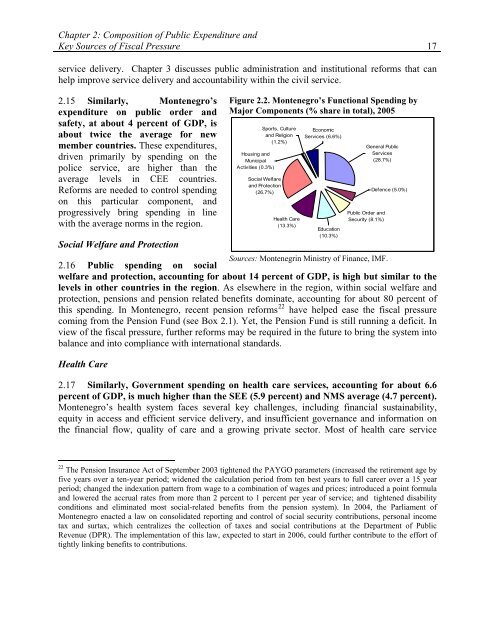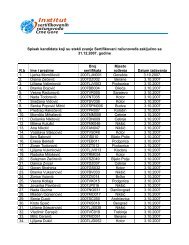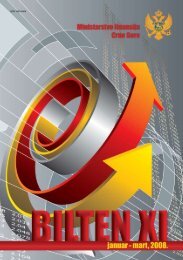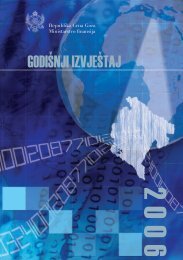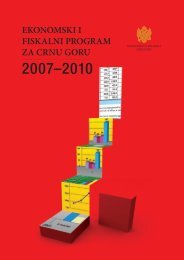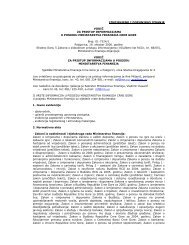Republic of Montenegro: Public Expenditure and ... - Vlada Crne Gore
Republic of Montenegro: Public Expenditure and ... - Vlada Crne Gore
Republic of Montenegro: Public Expenditure and ... - Vlada Crne Gore
Create successful ePaper yourself
Turn your PDF publications into a flip-book with our unique Google optimized e-Paper software.
Chapter 2: Composition <strong>of</strong> <strong>Public</strong> <strong>Expenditure</strong> <strong>and</strong><br />
Key Sources <strong>of</strong> Fiscal Pressure 17<br />
service delivery. Chapter 3 discusses public administration <strong>and</strong> institutional reforms that can<br />
help improve service delivery <strong>and</strong> accountability within the civil service.<br />
2.15 Similarly, <strong>Montenegro</strong>’s<br />
expenditure on public order <strong>and</strong><br />
safety, at about 4 percent <strong>of</strong> GDP, is<br />
about twice the average for new<br />
member countries. These expenditures,<br />
driven primarily by spending on the<br />
police service, are higher than the<br />
average levels in CEE countries.<br />
Reforms are needed to control spending<br />
on this particular component, <strong>and</strong><br />
progressively bring spending in line<br />
with the average norms in the region.<br />
Social Welfare <strong>and</strong> Protection<br />
Sources: Montenegrin Ministry <strong>of</strong> Finance, IMF.<br />
2.16 <strong>Public</strong> spending on social<br />
welfare <strong>and</strong> protection, accounting for about 14 percent <strong>of</strong> GDP, is high but similar to the<br />
levels in other countries in the region. As elsewhere in the region, within social welfare <strong>and</strong><br />
protection, pensions <strong>and</strong> pension related benefits dominate, accounting for about 80 percent <strong>of</strong><br />
this spending. In <strong>Montenegro</strong>, recent pension reforms 22 have helped ease the fiscal pressure<br />
coming from the Pension Fund (see Box 2.1). Yet, the Pension Fund is still running a deficit. In<br />
view <strong>of</strong> the fiscal pressure, further reforms may be required in the future to bring the system into<br />
balance <strong>and</strong> into compliance with international st<strong>and</strong>ards.<br />
Health Care<br />
Figure 2.2. <strong>Montenegro</strong>’s Functional Spending by<br />
Major Components (% share in total), 2005<br />
Housing <strong>and</strong><br />
Municipal<br />
Activities (0.3%)<br />
Sports, Culture<br />
<strong>and</strong> Religion<br />
(1.2%)<br />
Social Welfare<br />
<strong>and</strong> Protection<br />
(26.7%)<br />
Health Care<br />
(13.3%)<br />
Economic<br />
Services (6.6%)<br />
Education<br />
(10.3%)<br />
General <strong>Public</strong><br />
Services<br />
(28.7%)<br />
<strong>Public</strong> Order <strong>and</strong><br />
Security (8.1%)<br />
Defence (5.0%)<br />
2.17 Similarly, Government spending on health care services, accounting for about 6.6<br />
percent <strong>of</strong> GDP, is much higher than the SEE (5.9 percent) <strong>and</strong> NMS average (4.7 percent).<br />
<strong>Montenegro</strong>’s health system faces several key challenges, including financial sustainability,<br />
equity in access <strong>and</strong> efficient service delivery, <strong>and</strong> insufficient governance <strong>and</strong> information on<br />
the financial flow, quality <strong>of</strong> care <strong>and</strong> a growing private sector. Most <strong>of</strong> health care service<br />
22 The Pension Insurance Act <strong>of</strong> September 2003 tightened the PAYGO parameters (increased the retirement age by<br />
five years over a ten-year period; widened the calculation period from ten best years to full career over a 15 year<br />
period; changed the indexation pattern from wage to a combination <strong>of</strong> wages <strong>and</strong> prices; introduced a point formula<br />
<strong>and</strong> lowered the accrual rates from more than 2 percent to 1 percent per year <strong>of</strong> service; <strong>and</strong> tightened disability<br />
conditions <strong>and</strong> eliminated most social-related benefits from the pension system). In 2004, the Parliament <strong>of</strong><br />
<strong>Montenegro</strong> enacted a law on consolidated reporting <strong>and</strong> control <strong>of</strong> social security contributions, personal income<br />
tax <strong>and</strong> surtax, which centralizes the collection <strong>of</strong> taxes <strong>and</strong> social contributions at the Department <strong>of</strong> <strong>Public</strong><br />
Revenue (DPR). The implementation <strong>of</strong> this law, expected to start in 2006, could further contribute to the effort <strong>of</strong><br />
tightly linking benefits to contributions.


